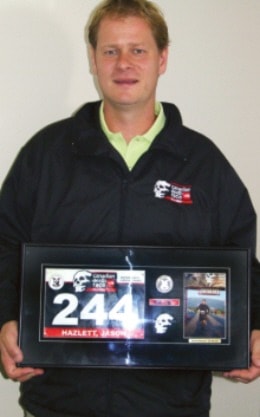By Treena Mielke
Pushing his mental discipline and physical endurance capabilities to the limits this summer, a Bentley teacher faced and overcame almost insurmountable odds in the Canadian Death Race.
Jason Hazlett successfully completed the 125-kilometre all-terrain extreme adventure race over three mountain summits and 17,000 feet of elevation change.
The Canadian Death Race began and ended at Grande Cache July 30 and 31.
Hazlett, who finished the race in 23 hours and 24 minutes, was thrilled to finish, even though his time was slower than last year’s when he completed the race in 22 hour and 46 minutes.
“The conditions were tougher than last year,” he said, noting that he was dealing with torrential rains and high winds during part of the journey.
It was an adventure that according to Hazlett, started out like a walk in the park, but eventually turned into a gruelling test that far surpassed any challenge he expected to face.
The first leg of the journey was 19 kilometres, including a net elevation loss of 500 feet. This leg included approximately six kilometres of pavement, followed by trail and a 3.5 kilometres of gravel road.
The course began in downtown Grande Cache and the race officially started at the five-kilometre mark, after passing the Grande Cache Saddle Club. The trail went past Grande Cache Lake and Peavine Lake. Runners were treated to a spectacular view of Peavine Lake and the mountains of Willmore Wilderness Park.
“This leg was a walk in the park by the lakes. It was very easy leg, a great warm up for the race,” said Hazlett.
The second leg of the journey, 27 kilometres, and characterized by long climbs, three kilometres of rough terrain and two creek crossings, was definitely tougher.
The trail from the summit of Flood Mountain to the summit of Grande Mountain is considered the roughest section of the race and the power line down the front of Grande Mountain that leads back to town is the most dangerous part due to steep, rocky drop-offs, said Hazlett.
“It’s very steep with loose gravel and shale,” he said. “This is one of the toughest legs of any trail race in the world.”
He recalled the Slugfest, a swampy, marshy area, as being particularly challenging and an area where he had to watch every step he took.
“I saw some runners fishing in the area for their shoes which they lost in the swamp,” said Hazlett.
The third leg comprised 21 kilometres of a direct road with several creek crossings. One creek ran directly down the trail, making the terrain especially slippery and rocky.
“It’s a total decline and very dangerous due to the shadowing from the trees, which hides the rocks. People don’t see the rocks, so they have to be very careful.”
Leg four, which was mostly dirt trail and hard packed gravel, was a nightmare for Hazlett when the weather became ugly. Torrential rain turned into sleet and high winds made for extremely gruelling conditions.
“I had fingerless gloves and my hands were frozen solid,” he said.
The ascent of Mount Hamel on leg four consisted of two long climbs. At the forestry tower on the summit, runners were required to check in and then retrieve a prayer flag as proof they have made the turnaround point.
On the descent, on a trail strewn with boulders and deep ruts, Hazlett was forced to contend with clay-like mud.
He plodded along, however, only to find his hopes dashed when he made it to the Ambler Aid Station where he had visions of changing into a dry set of clothes that were supposed to be waiting there.
However, the change of clothing had been left on top of a tarp and was covered with about four inches of water.
“I threw on the sopping clothes anyway,” he said. “And when I came into the last leg, leg five, surprisingly I started to warm up.”
The final leg of the Death Race was 24 kilometres long, including one kilometre of pavement, six kilometres of gravel and a river crossing. Hazlett said the first third of this leg was incredibly slow going due to the sticky black mud that covered the trail.
“It was very treacherous and very slow going. I had Gore-Tex shoes and the soles are very slippery. I felt like I was pulling a ball and chain with me.” He said the first seven kilometres should have taken about 45 minutes, but took two hours.
“The traction was terrible.”
The final two-thirds of the last leg were easier as he was able to run beside the trail on the grass, even though it was almost waist high.
Though Hazlett was cold, wet and exhausted, he knew he had enough strength to make it to the finish line.
“I knew that the people who had supported me all day would be stressed and worried, the longer I was on the course. That made me very motivated to finish the race. My support crew, Marcella Andeson and Sharon Zirk, who brought me food, clothes and shoes were great.”
After the race was over, Hazlett, though exhausted, could not sleep for several hours.
“I was not mentally done,” he said.
“And I was just wired from the glycogen mix I had taken (for energy).”
But, now with the race several weeks behind him, he is calm and relaxed, but already looking ahead to next year when he plans to compete in the Sinister 7, a race with similar challenges.
Racing is a great challenge and completing a race is a wonderful high, he said.
“Physically being unable to go on because of injury is the only thing other than being timed out that would make me not finish the Death Race. After all, pain is temporary, but pride is forever.”
